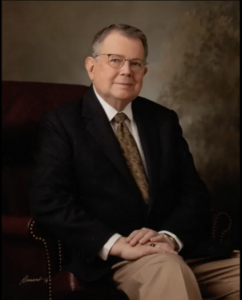 We are saddened to hear that Steven P. Sondrup, a former BYU comparative literature professor, passed away on November 10, 2020. Sondrup was one of the founders of the Association for Mormon Letters and was a key figure in the organization’s development for its first eighteen years.
We are saddened to hear that Steven P. Sondrup, a former BYU comparative literature professor, passed away on November 10, 2020. Sondrup was one of the founders of the Association for Mormon Letters and was a key figure in the organization’s development for its first eighteen years.
Steven Preece Sondrup was born on May 27, 1944, to Walter and Louise Sondrup, and was the eldest of three children. He attended schools in Salt Lake City and served as an LDS missionary in Germany and Italy, before graduating magna cum laude from the University of Utah with a BA in German. He then earned MA and PhD degrees (1974) at Harvard University, focusing on modern German and Scandinavian literature. From his dissertation came his first book, Hofmannsthal and the French Symbolist Tradition (1976). He would go on to publish works on Goethe, Stendahl, Flaubert, Zola, Strindberg, Lundkvist, Sjöstrand, Manzani, Laxness, Høeg, H. C. Anderson, theories of the self, romantic fiction, post-colonial poetry, and comparative poetics.
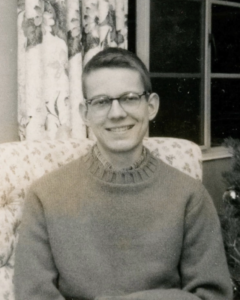 After graduating from Harvard, Steven returned home to Utah and began teaching at Brigham Young University in 1973 as a Professor of Comparative Literature. He diligently studied languages his entire life, gaining proficiency in nine languages. He earned BYU’s most prestigious faculty award, the Karl G. Maeser Research and Creative Arts Award, in 1982.
After graduating from Harvard, Steven returned home to Utah and began teaching at Brigham Young University in 1973 as a Professor of Comparative Literature. He diligently studied languages his entire life, gaining proficiency in nine languages. He earned BYU’s most prestigious faculty award, the Karl G. Maeser Research and Creative Arts Award, in 1982.
In 1976 Steven participated in the creation of the Association for Mormon Letters, with Maureen Ursenbach Beecher, Eugene England, Lavina Fielding Anderson, and others. Sondrup attended the first organizing meeting in April 1976 in the Historical Department in the Church Office Building in Salt Lake City and became the first executive secretary (and, for a time, treasurer), a position he would hold for over 17 years. He also edited the AML Newsletter for most of those years and edited the AML conference proceedings volumes from 1979 to 1987. He served as the organizational backbone as presidents and boards came and went, keeping the AML together during lean times, including when the organization came close to disbanding in 1988. In that year, when it looked like the annual conference would not be held, he volunteered to host the presidential address and presentation of awards at his own home in Salt Lake City. He frequently hosted AML board meetings and is well remembered as a warm and gracious host who prepared delicious food.
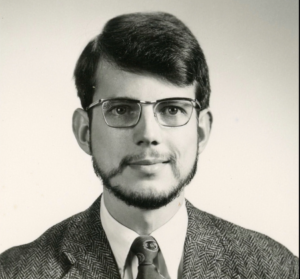 Steven turned his academic gifts to the study to Mormon literary scholarship in the years immediately after the founding of AML. He presented the paper “Literary Dimensions of Mormon Autobiography”, in which he examined autobiographies by Parley P. Pratt, Annie Clark Tanner, and Spencer W. Kimball, and gave suggestions for critical readings, at AML’s second conference in 1977, and it was published Dialogue. It won an AML Award for Criticism.
Steven turned his academic gifts to the study to Mormon literary scholarship in the years immediately after the founding of AML. He presented the paper “Literary Dimensions of Mormon Autobiography”, in which he examined autobiographies by Parley P. Pratt, Annie Clark Tanner, and Spencer W. Kimball, and gave suggestions for critical readings, at AML’s second conference in 1977, and it was published Dialogue. It won an AML Award for Criticism.
Perhaps Steven’s most influential work in Mormon literature was “The Psalm of Nephi: A Lyric Reading”, presented at the 1979 AML Conference and published in BYU Studies. This was a pioneering work in literary analysis of the Book of Mormon. Sidney Sperry had apparently first called the passage a “psalm” in 1947, but Steven was the first to analyze the poetic structure and value of the verses, comparing it to biblical psalms and other lyric poetry. Book of Mormon Central stated, “He noted that the passage contains structure, rhythm, parallelism, chiasms, verbal pairings, couplets, triplets, and other features of intentional poetic structuring. Furthermore, Sondrup concluded that ‘logical, formal or conceptual units are set parallel one to another’ as they are in the Hebrew poetry of the Old Testament.”[1] Beyond an attempt to try to prove the historicity of passage, however, he emphasized the importance of recognizing the literary conventions used in texts to enrich a reader’s understanding of the author’s message.
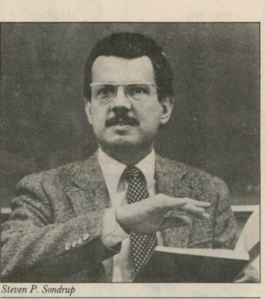 Other scholarship he produced on Mormon literature include “The Possibility of Mormon Tragedy” (Rocky Mountain MLA, 1981, published in AML Proceedings, 1979-82), “On Confessing Belief: Thoughts on the Language of the Articles of Faith”. Literature of Belief, edited by Neal E. Lambert, 1981, “Levi Peterson’s ‘The Road to Damascus’ and the Language of Grace” (AML Annual, 1984, and Literature and Belief, vol. 5, 1985, and “Halldor Laxness and the Politics of Paradise” (Ideal Places in History: East and West, 1997).
Other scholarship he produced on Mormon literature include “The Possibility of Mormon Tragedy” (Rocky Mountain MLA, 1981, published in AML Proceedings, 1979-82), “On Confessing Belief: Thoughts on the Language of the Articles of Faith”. Literature of Belief, edited by Neal E. Lambert, 1981, “Levi Peterson’s ‘The Road to Damascus’ and the Language of Grace” (AML Annual, 1984, and Literature and Belief, vol. 5, 1985, and “Halldor Laxness and the Politics of Paradise” (Ideal Places in History: East and West, 1997).
Perhaps Steven’s most significant contribution to the field was his editing of Art and Inspiration: Mormon Perspectives(Brigham Young University Press, 1980), which featured essays by eighteen artists, critics, and commentators, exploring Mormon arts and aesthetics. James Goldberg recently commented, “The diversity of contributors Steven Sondrup gathered is jaw-dropping. Writers come from Austria, Canada, Denmark, Germany, Hawaii, India, Japan, the mainland United States, and Zimbabwe; they include artists across disciplines, various scholars, an apostle, and a surgeon. It blew my mind when I ran across the book because I’d never 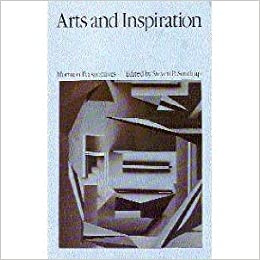 seen a collection of Mormon arts criticism so wide or ambitious. Sondrup set a high bar and left us huge shoes to fill.” William Morris stated, “Arts and Inspiration was–and still is–unique in the world of Mormon Studies for its focus on the experiences of a wide variety of artists, including voices from the world of performing arts ans non-white artists, while also including essays by the likes of Boyd K. Packer and Wayne C. Booth. For me, discovering it on the shelves of the Bancroft Library at UC Berkeley was incredibly important to my development as a critic and writer of Mormon fiction.”[2]
seen a collection of Mormon arts criticism so wide or ambitious. Sondrup set a high bar and left us huge shoes to fill.” William Morris stated, “Arts and Inspiration was–and still is–unique in the world of Mormon Studies for its focus on the experiences of a wide variety of artists, including voices from the world of performing arts ans non-white artists, while also including essays by the likes of Boyd K. Packer and Wayne C. Booth. For me, discovering it on the shelves of the Bancroft Library at UC Berkeley was incredibly important to my development as a critic and writer of Mormon fiction.”[2]
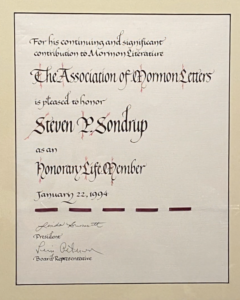 Steven was made an AML honorary life member in January 1994, as he stepped down from his longtime position as secretary of the organization. He continued use his skills in academic service, serving as the editor of the Society for the Advancement of Scandinavian Study’s quarterly journal from 1991 to 2003 and holding various positions in the International Comparative Literature Association, including editor for the ICLA Bulletin for many years, Treasurer, and President. Both organizations have produced thoughtful memoriam pieces by people who knew Steven well (the SASS in memoriam is by Chip Oscarson, a former student of Steven’s and currently an associate professor of comparative arts and letters at BYU).
Steven was made an AML honorary life member in January 1994, as he stepped down from his longtime position as secretary of the organization. He continued use his skills in academic service, serving as the editor of the Society for the Advancement of Scandinavian Study’s quarterly journal from 1991 to 2003 and holding various positions in the International Comparative Literature Association, including editor for the ICLA Bulletin for many years, Treasurer, and President. Both organizations have produced thoughtful memoriam pieces by people who knew Steven well (the SASS in memoriam is by Chip Oscarson, a former student of Steven’s and currently an associate professor of comparative arts and letters at BYU).
Link to ICLA in memoriam: https://www.ailc-icla.org/in-memoriam-steven-sondrup/
Link to SASS in memoriam: https://scandinavianstudy.org/news-notes-november-2020/
Jenny Webb, the former President of the Mormon Scholars in the Humanities, provides this memory of working with Steven on the SASS journal as a BYU student, where she eventually became the production manager. “We all shared a small, windowless office in the basement of the HRCB, and it became my campus ‘home’ during grad school. Steven was exacting, opinionated, and brilliant. He was also incredibly generous with his time, showing me how an editor can nurture a promising piece, talking to me and the other students about an impossibly wide range of topics (all of which he seemed to have mastered), and taking students along with him as he traveled to his various conferences and events to facilitate networking and demonstrate how one might participate in broad scholarly communities. By the time I graduated with my MA, I had acquired practical skills as an editor and in book design, along with a solid sense that I could continue to participate in the academy despite my peripheral position as a trailing spouse with a terminal degree. I worked as an academic editor for over 15 years using those skills; at the same time, I continued to give papers and participate in the academy to the extent that in 2020 I was able to start a PhD program. It’s no exaggeration to say that the shape of my life has been profoundly impacted by Steven’s influence.”
Steven retired from BYU in 2016. In his later years he was diagnosed with Parkinson’s and cancer, but Chip Oscarsson notes, “He patiently and actively carried on his work on an ambitious three volume history of Nordic literature involving scores of Scandinavianists working on both sides of the Atlantic.”
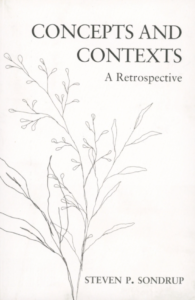 His final book was Concepts and Contexts: A Retrospective, published in 2020. The blurb states, “This collection provides a representative retrospection of the work of Dr. Steven P. Sondrup during the course of his career. They have been organized chronologically in order to provide a sense of the development of the author’s thought and scholarship over the years . . . Specializing in nineteenth and twentieth-century literature, Steven Sondrup published on a wide variety of topics, often dealing with, though never limited to, the works of German Romanticism and the Scandinavian literatures. The representative pieces here demonstrate both the breadth and the depth that is the hallmark of truly creative, rich comparative work.The authors considered here include well known figures such as Hofmannsthal, Lundkvist, Strindberg, Zola, Goethe, Laxness, Virgil, Ovid, Kafka, and Kierkegaard among others, but also contemporary authors such as Levi Peterson, Derek Walcott, Amy Tan, and Peter Høeg. Whoever, wherever, and whenever he is reading, Steven Sondrup displays an ability to read with care, comparative precision, and creativity, and we are left enriched by the experience.”
His final book was Concepts and Contexts: A Retrospective, published in 2020. The blurb states, “This collection provides a representative retrospection of the work of Dr. Steven P. Sondrup during the course of his career. They have been organized chronologically in order to provide a sense of the development of the author’s thought and scholarship over the years . . . Specializing in nineteenth and twentieth-century literature, Steven Sondrup published on a wide variety of topics, often dealing with, though never limited to, the works of German Romanticism and the Scandinavian literatures. The representative pieces here demonstrate both the breadth and the depth that is the hallmark of truly creative, rich comparative work.The authors considered here include well known figures such as Hofmannsthal, Lundkvist, Strindberg, Zola, Goethe, Laxness, Virgil, Ovid, Kafka, and Kierkegaard among others, but also contemporary authors such as Levi Peterson, Derek Walcott, Amy Tan, and Peter Høeg. Whoever, wherever, and whenever he is reading, Steven Sondrup displays an ability to read with care, comparative precision, and creativity, and we are left enriched by the experience.”
We wish to express our deepest sympathies to Steven’s friends and family.
[1]Book of Mormon Central, “Is ‘Nephi’s Psalm’ Really a Psalm?”, 2016 [2] Karl Keller, a literary scholar who had frequently written about Mormon literature in earlier decades, but had long left the Church by 1980, wrote a very negative review of the collection in Dialogue, stating that true art is antithetical to a society that values religious authority and dogma, and for seeming to claim that Mormon criticism could somehow generate Mormon art.

Arts and Inspiration: Mormon Perspectives, 1980.
Table of Contents:
Theoretical Foundations
Boyd K. Packer, “The Arts and the Spirit of the Lord.”
Candadai Seshachari, “Insights from the Outside: Thoughts for the Mormon Writer.”
Wayne C. Booth, “Religion versus Art: Can the Ancient Conflict Be Resolved?”
Nicolas Shumway, “Art and Worship: Toward a Theoretical Accommodation.”
Karen Lynn, “The Mormon Sacred and the Mormon Profane: An Aesthetic Dilemma.”
Edward L. Hart, “The Relevance of Literature: A Mormon Viewpoint.”
Cross-Cultural Considerations
Ishmael W. Stagner, “Art, Culture, and the Gospel of Jesus Christ: A Hawaiian Perspective.”
Richard G. Oman, “Divergent Cultures and Gospel Brotherhood.”
Artists on the Arts
Johan H. Benthin, “Thoughts on Art and Inspiration.”
Merrill Bradshaw, “Music and the Spirit: A Mosaic.”
Herbert Harker, “Excavating Myself.”
Debra Sowell, “Dance Talk.”
Reid Nibley, “Facing the Music: The Challenges Ahead for Mormon Musicians.”
Trevor Southey, “‘The Outer Image of Inward Things’.”
Art and Life
Ruth Hoen, “Music: That Influential Muse.”
Yoshie Akimoto Eldredge, “Talents.”
Jon Carroll Lloyd, “‘To Enter Arcanum’.”
Johann Wondra, “Art: A Possibility for Love.”